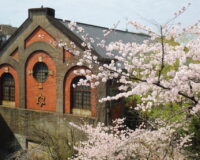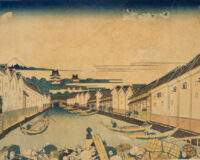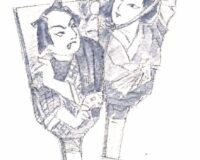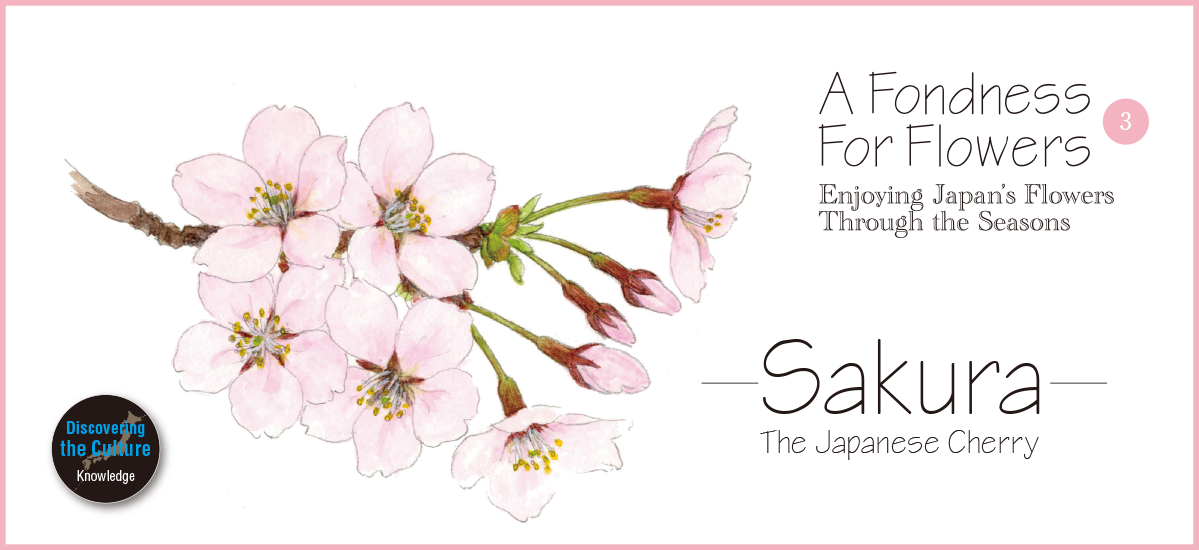
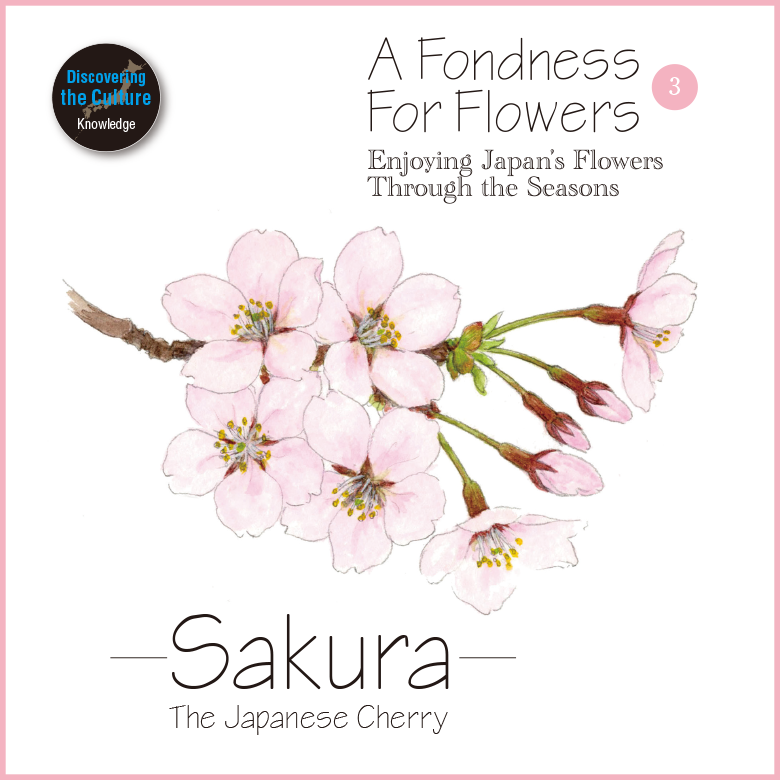
Flowering plants are intricately woven into the tales and legends of Japan, and feature prominently in Japanese art and poetry. Brimming with intelligence and ingenuity, the flowering plants all around us herald the coming of the seasons. Whether you live in Japan or are here as a visitor, take a moment to look about and see what the flowers have to tell you.
Illustration : Aso Yuriko / English Version : Judy Evans
Keyword : Man’yōshū / Sakura / Cherry Blossom / okin Waka-shū / Somei Yoshino / Prunus x yedoensis / Sakura Mochi
Sakura (桜) – The Flowering Cherry
Plant Family: Rosaceae.
Botanical name: Species include Prunus serrulata; Prunus lannesiana; Prunus pendula; Prunus x yedoensis, and others.
Common Japanese name: Sakura
Common English names: Flowering cherry; ornamental cherry
Place of origin: The Himalayas
Prefectural tree: Tokyo City (Somei-yoshino); Yamanashi Prefecture (Fuji-zakura); Kyoto Prefecture (Shidare-zakura); Nara Prefecture (Nara-yaezakura); Miyazaki Prefecture (Yama-zakura).
Language of Flowers: Moral beauty; feminine grace; chastity; wealth and prosperity.
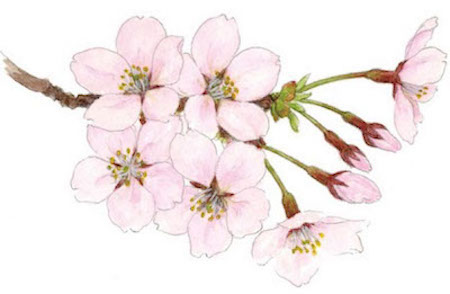
Plum Blossom or Cherry Blossom – Which is Japan’s Most Iconic Flower?
Plum blossom and cherry blossom are both hugely iconic within Japan but their relative status in the popularity stakes has subtly changed over the centuries. This is reflected in the way the two flowers appear in literature from the Nara Period (710 – 794) and the Heian Period (794 – 1185), respectively.
During the Nara Period, when the word “hana” (flower) popped up in a poetic context, it most likely referred to plum blossom. Plum blossom features in one hundred and eighteen poems, and cherry blossom in only forty, in the Man’yō-shū, an anthology of poetry compiled during the Nara Period. This suggests that plum blossom was the flower in the forefront of people’s minds at that time.
However, the situation was reversed by the Heian Period. Of the 1,100 poems in the Kokin Waka-shū anthology from this period, sixty-one mention cherry blossoms and twenty-eight mention plum blossom. Cherry blossom has retained its celebrity status ever since – in fact, it is considered by many to be Japan’s (unofficial) national flower.
What Makes the Cherry Trees All Bloom at Once?
As soon as the weather becomes warm enough in spring, Japan’s ornamental cherry trees burst into flower, blooming en masse in parks and along river banks. One of the best-known cultivated varieties is the Yoshino cherry, known in Japan as Somei Yoshino, a cultivar of Prunus x yedoensis. This hybrid is believed to have appeared towards the end of the Edo Period (1603 – 1868) as the result of the crossbreeding of two parent species, the Ōshima-zakura (Prunus speciosa) and the Edo-higan (Prunus pendula).
The Somei Yoshino is celebrated for its particularly showy blossoms, a spectacle that’s amplified by the way all the trees in a given area flower at the same time. But what is it that prompts all these trees to flower at once?
The answer lies in the way Somei Yoshino is propagated. All Somei Yoshino trees (and there are now hundreds of thousands of them all around Japan) are clones that trace back to that original tree hybridized way back in the Edo Period. What this means is that rather than being grown from seed, these trees are produced by taking stem sections (scions) from a donor tree and grafting them onto rootstock from a closely related Prunus species. Because all the scions are genetically identical to the original tree, all trees propagated in this way will also be identical to the original tree. This means that they will all respond in exactly the same way to environmental conditions in any given location – which is why they all burst into flower at the same time.
You might be thinking that grafting hundreds of thousands of Somei Yoshino trees is an awful lot of work – wouldn’t it just be easier to grow them from seed? The answer to that question is that Somei Yoshino cannot be grown from seed, they can only be propagated vegetatively (asexually) from cuttings. Plant growers could certainly try to produce seeds by crossbreeding Somei Yoshino’s two parent species, but trees grown from the resulting seeds would not have exactly the same characteristics as Somei Yoshino.
This makes sense if you think about it in human terms. After all, with the exception of identical twins, none of us looks exactly the same as our siblings. Likewise, cherry trees grown from the seeds of an Edo higan cherry tree fertilized by pollen from an Ōshima-zakura tree would be siblings of Somei Yoshino. While there would be a family resemblance, there would also be variation in the size of the leaves and flowers, as well as in the colour and quantity of flowers from one tree to another.
The Legacy of Edo Period Plant Breeders
As a cultivar, Somei Yoshino would have been selected for its desirable characteristics from among a number of sibling varieties by Edo Period plant breeders. In order to produce and sell more trees with the same characteristics, these Edo Period breeders would have taken cuttings from the tree they identified as having desirable traits, grafting them onto readily available rootstock, a practice that has continued in an unbroken line ever since.
Just what were the traits that those Edo Period plant breeders found so attractive in the tree that would later become known as the Somei Yoshino? One characteristic was the sheer number of flowers. There must be hundreds of thousands of blossoms on each tree. Next time you see a mature Somei Yoshino in full bloom, try counting them!
Another desirable characteristic of the Somei Yoshino is that the blossoms appear on the branches before the leaves do. Without any leaves to obscure their frothy exuberance, the blossoms create a much more striking impression.
Winter’s Approach Predicted by Lengthening Nights
Let’s take a closer look at the science of cherry blossoms and the behind-the-scenes activity that goes into getting these blossoms ready to burst into life in spring. Flower initiation (when the flower buds begin forming) in cherry trees occurs in summer. However, rather than continuing their growth and opening in autumn, flower bud development is suspended until the following spring. After all, if cherries flowered in autumn, the cold weather that follows would prevent them from fruiting and setting seed, and this would see the eventual demise of the species.
In order not to open at the wrong time, and to protect themselves from the harsh winter cold, the developing flower buds encase themselves in a tough, scaly outer layer, transforming themselves into “overwintering buds”.
If they are to protect the tender floral parts inside them, these overwintering buds must begin forming well in advance of the arrival of cold weather. The cherry tree predicts the onset of winter through its leaves, which do this by tracking increasing night length. Nights begin to grow longer once we pass the summer solstice in June, and don’t begin to shorten again until the winter solstice occurs in late December. This is still some weeks before winter temperatures reach their lowest point sometime in February.
When night length increases to a certain point, the leaves send a message to the developing flower buds to start forming their protective layer. This message arrives in the form of abscisic acid, which the leaves produce in increasing amounts as nights grow longer. One of the functions of abscisic acid is to induce dormancy, which it does by supressing the development of the floral parts of the bud and prompting it to form its scaly protective layer.
Why do Cherry Blossoms Open after a Typhoon?
From time to time we see reports of cherry trees bursting into flower after a typhoon has swept through. This news is often accompanied by much puzzlement but if we think about the role that leaves play in suppressing the development of the blossoms until spring, the phenomenon is not that puzzling at all.
Typhoons arrive bringing salt-laden air from the sea, which is deposited on everything it touches, including the leaves of trees. Most typhoons are accompanied by plenty of rain, so most of this salt gets washed off. However, when typhoons don’t bring much rain, the salt remains clinging to the leaves, leading to salt damage that kills the leaves and causes them to drop off. Without any leaves to send abscisic acid to the flower buds, the buds continue developing instead of going into dormancy and, hey presto, autumn cherry blossoms. The same phenomenon would occur if the trees lost their leaves for any other reason (such as insect damage) before the overwintering buds had formed.
Perhaps this unseasonal post-typhoon blossoming of cherry trees could be considered a parting gift from the typhoon!
Cold Temperatures Break Dormancy, Warm Temperatures Prompt Flowering
Assuming that all goes according to plan in autumn and no salt-laden winds arrive to strip the cherry trees of their leaves before the flower buds have entered dormancy, it’s just a matter of waiting for warm weather so that the cherry trees can burst into flower, right? Well, no – not quite.
Once the flower buds enter dormancy, they won’t open simply just because the weather gets warm. Even if a cherry tree laden with overwintering flower buds is moved to a warm location in early winter, the buds won’t open. These buds are dormant and as long as they contain enough abscisic acid to keep them that way, they won’t bloom until they’re ready – no matter how warm the weather gets.
What does it take to get rid of the abscisic acid in the flower buds so that we can enjoy the cherry blossoms? It turns out that what is needed is cold weather, and lots of it. Cold temperatures break down the abscisic acid over time and when this hormone falls below a certain level, the buds awaken from their dormant state.
However, breaking dormancy is only the first part of a two-part equation. When the winter cold breaks down the abscisic acid and awakens the overwintering buds, it’s still far too cold for the blossoms to open. Instead, they bide their time inside their protective layer, waiting for the next step to occur.
That next step, the production of a plant hormone called gibberellin in the flower bud, can only occur when temperatures become warm enough. Warm temperatures prompt the buds to produce gibberellin, and gibberellin stimulates the buds to complete their development and burst into flower.
Cherry Blossom Telegrams Announce Academic Success
There was once a time in Japan when the results of university entrance exams were sent to candidates by telegram. Like cherry blossoms, these much-anticipated telegrams (written in a kind of cherry blossom-derived code) arrived in early spring. If a telegram read “sakura saku” (cherry blossoms bloom), the candidate had been successful. In light of the long months of effort that a student spends preparing for entrance exams, this seems appropriate enough. Entrance exam candidates’ efforts are not unlike the months of work that cherry trees put into preparing their spring spectacle.
However, for unsuccessful candidates, the telegram would read “sakura chiru” (cherry blossoms fall). It might be taking things a bit too literally to argue that cherry blossoms can’t fall if they’ve never opened in the first place, but I do think more appropriate wording could have been used. How about “sakura sakazu” (cherry blossoms don’t bloom), or “sakura katashi” (cherry blossoms are difficult)? Admittedly, it sounds better in Japanese!
What’s Behind the Fragrance of Sakura Mochi?
Aside from cherry blossoms, one of the things we look forward to in spring is sakura mochi, a traditional sweet wrapped in a pickled cherry leaf. This salty leaf has a distinctive sweet fragrance somewhat like almond extract. Given that leaves picked freshly from an ordinary cherry tree have no such fragrance, what kind of leaves are used for sakura mochi? Actually, leaves from the Ōshima-zakura cherry tree are most commonly used. This is mainly because they are large and tender, but also because they produce a good fragrance. However, the distinctive fragrance only occurs after the leaves have been pickled in salt. Any cherry tree leaves can used for shio-zuke (salt pickles) and will produce the desired fragrance, but most varieties (including Somei Yoshino) have tough leaves that are difficult to work with and unpleasant to eat.
The sweet fragrance of shio-zuke sakura leaves comes from the aromatic organic compound, coumarin. While coumarin is not present in fresh cherry leaves, the substances needed to synthesize this compound are. The only thing is, because they don’t come in contact with each other, fresh cherry leaves have no fragrance. It is not until the cell walls inside the leaves are broken down during the salt-pickling process that these substances come into contact and react with each other, resulting in the production of coumarin.
If you pick a fresh cherry leaf and roll it between your hands, crushing and bruising it, you may detect a faint aroma of coumarin. This is because coumarin is produced when the leaf is damaged in this way. Coumarin production is part of the leaf’s defense mechanism – insects damage the leaves when they try to chew them, so the damaged leaf responds by producing this fragrance that deters insects.
Text: Osamu Tanaka
Emeritus Professor at Kōnan University, Kōbe. Born in Kyōto, 1947. Studied in the Faculty of Agriculture, Kyōto University, where he earned his doctorate. Post-doctorate activities include a doctoral research fellowship at the Smithsonian Institution (United States), before becoming a lecturer in the Faculty of Science and Engineering at Kōnan University in Kōbe. A prolific author, Dr Tanaka has written many, many books, including Fushigi no Shokubutsugaku (The Wonders of Botany), Shokubutsu wa Sugoi (Plants are Amazing!), Shokubutsu no Himitsu (Plant Secrets), and Zassō no Hanashi (Speaking of Weeds), published by Chūōkōron-shinsha; Nyūmon Tanoshii Shokubutsugaku (Fun Introductory Botany) and Furūtsu Hitotsu-banashi (Tales of Fruit), pub. Kōdansha; Arigatai Shokubutsu (Plants to be Grateful for), pub. Gentōsha; Shokubutsu no Kashikoi Ikikata (Clever Plant Behaviour), pub. SB Shinsho; Shokubutsu no Ikiru Shikumi ni Matsuwaru 66-dai (66 Topics Related to Plant Life Systems), pub. Science Eye Shinsho; and Shokubutsu wa Oishii (Plants are Delicious), pub. Chikuma Shinsho.
Please note: The book title translations in parentheses are literal translations of the Japanese titles, provided for the benefit of our English-speaking readers. These translations are not actual published book titles.


